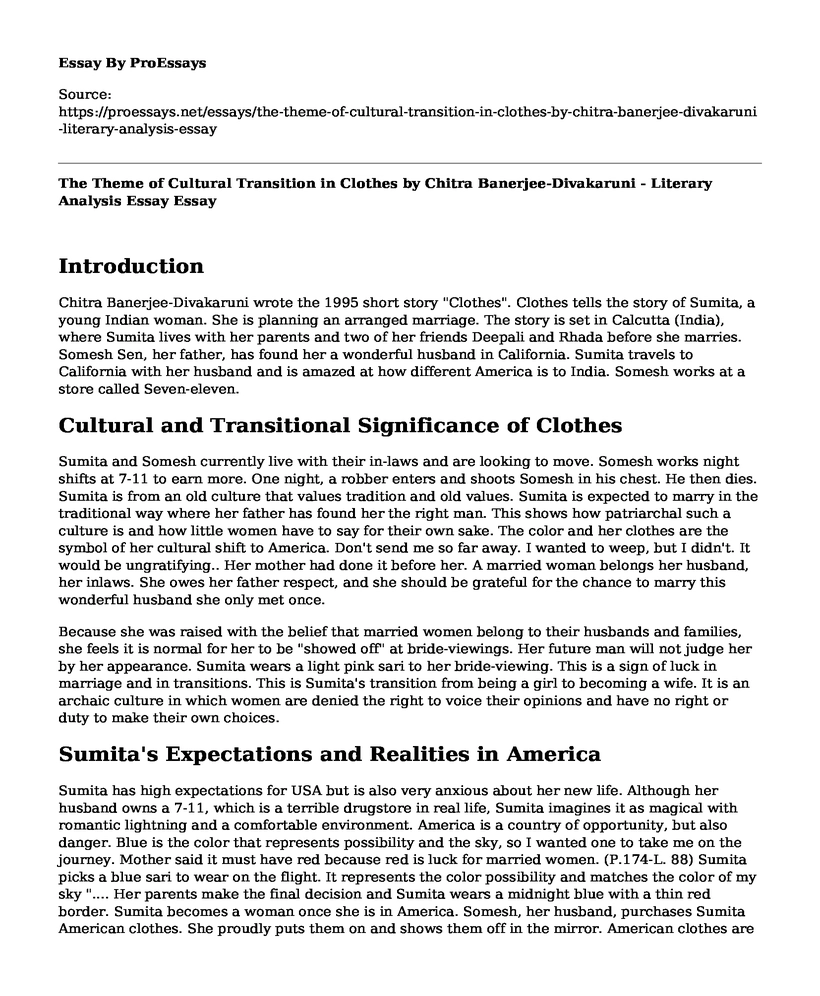Introduction
Chitra Banerjee-Divakaruni wrote the 1995 short story "Clothes". Clothes tells the story of Sumita, a young Indian woman. She is planning an arranged marriage. The story is set in Calcutta (India), where Sumita lives with her parents and two of her friends Deepali and Rhada before she marries. Somesh Sen, her father, has found her a wonderful husband in California. Sumita travels to California with her husband and is amazed at how different America is to India. Somesh works at a store called Seven-eleven.
Cultural and Transitional Significance of Clothes
Sumita and Somesh currently live with their in-laws and are looking to move. Somesh works night shifts at 7-11 to earn more. One night, a robber enters and shoots Somesh in his chest. He then dies. Sumita is from an old culture that values tradition and old values. Sumita is expected to marry in the traditional way where her father has found her the right man. This shows how patriarchal such a culture is and how little women have to say for their own sake. The color and her clothes are the symbol of her cultural shift to America. Don't send me so far away. I wanted to weep, but I didn't. It would be ungratifying.. Her mother had done it before her. A married woman belongs her husband, her inlaws. She owes her father respect, and she should be grateful for the chance to marry this wonderful husband she only met once.
Because she was raised with the belief that married women belong to their husbands and families, she feels it is normal for her to be "showed off" at bride-viewings. Her future man will not judge her by her appearance. Sumita wears a light pink sari to her bride-viewing. This is a sign of luck in marriage and in transitions. This is Sumita's transition from being a girl to becoming a wife. It is an archaic culture in which women are denied the right to voice their opinions and have no right or duty to make their own choices.
Sumita's Expectations and Realities in America
Sumita has high expectations for USA but is also very anxious about her new life. Although her husband owns a 7-11, which is a terrible drugstore in real life, Sumita imagines it as magical with romantic lightning and a comfortable environment. America is a country of opportunity, but also danger. Blue is the color that represents possibility and the sky, so I wanted one to take me on the journey. Mother said it must have red because red is luck for married women. (P.174-L. 88) Sumita picks a blue sari to wear on the flight. It represents the color possibility and matches the color of my sky ".... Her parents make the final decision and Sumita wears a midnight blue with a thin red border. Sumita becomes a woman once she is in America. Somesh, her husband, purchases Sumita American clothes. She proudly puts them on and shows them off in the mirror. American clothes are a sunrise orange tshirt with the words "Great America" and matching jeans.
Sumita's Journey to Independence and Empowerment
Sumita realises at this point that she is an Indian young woman. Sumita has beautiful breasts, hips, and curves. Sumita is now more independent than she was when she left India. The in-laws still make the decisions about what Sumita wears. One night, Somesh is robbed in his store. The robber steals the money and then shoots Somesh. Sumita now wears a plain white sari and thick voile. "White. Widows color, color for endings. Sumita is now a widow. She is almost fully grown.
According to her in-laws, she should return to India with them. She will be back at square one if she returns. She can be an American woman and become a teacher of girls in America if she stays. The story ends with "She wears a blouse, skirt and hat the color of almonds." "(P. 183-L8). Almonds, brown, natural. She decides to remain in America and become an independent woman. Sumita is now an independent American woman, having gone from being a dependent Indian girl to being grown up.
Cite this page
The Theme of Cultural Transition in Clothes by Chitra Banerjee-Divakaruni - Literary Analysis Essay. (2022, Aug 03). Retrieved from https://proessays.net/essays/the-theme-of-cultural-transition-in-clothes-by-chitra-banerjee-divakaruni-literary-analysis-essay
If you are the original author of this essay and no longer wish to have it published on the ProEssays website, please click below to request its removal:
- How Achebe's Things Fall Apart Responds to the White Man's Burden Poem
- Marxist Theory on Hamlet: Research Paper
- How Native Americans Were Affected by the US 1778-1900
- The Language of the Third Reich Essay Example
- Essay Example on PopCult and PostFem: Attitudes and Influences
- Essay Sample on Transforming Life Through Family Violence Intervention Program
- Family Dynamics: Its Influence on Personal Relationships - Essay Sample







